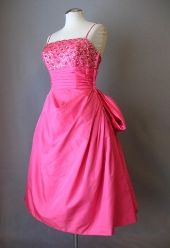 Sophie Gimbel, 1959
Sophie Gimbel, 1959Sophie Gimbel, also known as Sophie of Saks, was one of America's most influential designers in the 1930s, 40s, and 50s. Born Sophie Haas in 1898 in Houston, TX, she moved to Atlanta, GA at age 4 after the death of her father. She attended Agnes Scott College there. At age 19, Sophie married Harry Rossbach and moved to Philadelphia. She had one son, Jay, and worked as a part-time costume designer for the theatre.
 Sophie-gimbel ensemble, 1942
Sophie-gimbel ensemble, 1942After divorcing Harry in 1926, Sophie moved to New York, where she was hired as a stylist by Adam Gimbel, president of Saks Fifth Avenue (she married Gimbel in 1931). In 1929, she was asked to take over the Salon Moderne, Saks' couture department. Prior to Sophie's taking over, the Salon had not been terribly successful. Within three years, however, Sophie had tripled the sales of the department. The Salon Moderne sold French couture from such designers as Chanel, Vionnet, and Schiaparelli alongside Sophie's own collections, which bore her name on the label, sophie-gimbel. In the 40s, the label was changed to Sophie of Saks.
 Sophie Originals evening dress, 1949. Photo by Louise Dahl Wolfe.
Sophie Originals evening dress, 1949. Photo by Louise Dahl Wolfe.Sophie also worked with Emmet Joyce to design the Saks Originals ready-to-wear collections. In the 1940s, Sophie Gimbel sold more clothes than any other American designer, with the possible exception of Hattie Carnegie, who was Sophie's main competitor. She paid little attention to trends, preferring instead simple and elegant garments which were produced in expensive fabrics.
 Sophie Originals ready-to-wear dress, Fall 1961.
Sophie Originals ready-to-wear dress, Fall 1961.During WWII, Sophie became one of the world's most influential designers, as there was no couture coming out of Paris. After the war, she resumed buying Paris couture to copy in the Saks workrooms, but she found that her own designs were more popular. She then cut back on buying Paris fashions and concentrated on offering her own custom garments along with her ready-to-wear designs. Beginning in 1955, Sophie also designed custom wedding gowns.
 Sophie Gimbel, at right, sits in the Salon with a customer, 1960.
Sophie Gimbel, at right, sits in the Salon with a customer, 1960.Sophie's clothes were always feminine and classic, and were made in luxurious fabrics. She had a unique color sense, often using unusual colors, especially for her evening wear. Her designs often featured bows, a favorite adornment of hers.
 Sophie of Saks beaded evening gown, 1963.
Sophie of Saks beaded evening gown, 1963.Sophie retired in 1969. She died on November 28, 1981. In 1942, she was quoted as saying, "You don't have to have lots of clothes in order to be chic. But you most certainly have to have the right clothes." Those words still ring true today, after nearly 70 years.
Please note: Biographical information about Sophie Gimbel is copyright of Couture Allure and may not be copied without permission.
 I've seen the term "Kharafleece" in many Jantzen ads and on the labels of lots of their sweaters. I've often wondered what the term meant. I finally got a clue when reading the ad above from 1954. In the 1950s, sweater companies would name their exclusive yarn blends as a marketing strategy. Garland had "Dreamspun", Nan Dorsey had "Fabulon", Darlene had "Melospun", etc, etc.
I've seen the term "Kharafleece" in many Jantzen ads and on the labels of lots of their sweaters. I've often wondered what the term meant. I finally got a clue when reading the ad above from 1954. In the 1950s, sweater companies would name their exclusive yarn blends as a marketing strategy. Garland had "Dreamspun", Nan Dorsey had "Fabulon", Darlene had "Melospun", etc, etc. What is "Kharafleece"? It was Jantzen's exclusive blend of lambswool, Vicara, and nylon yarn that was mothproofed by Mitin. Here's an earlier post of mine about Mitin. Vicara was a fiber produced by the Virginia-Carolina Corporation. It was made from the extruded plant protein Zein, which comes from corn. Vicara was soft as cashmere, washable, and took dyes well. It had to be blended with other fibers, though, as it was not as durable. Vicara production was discontinued in 1958 due to the advent of better performing synthetic fibers. If you have a Kharafleece sweater by Jantzen, you can properly date it prior to 1959.
What is "Kharafleece"? It was Jantzen's exclusive blend of lambswool, Vicara, and nylon yarn that was mothproofed by Mitin. Here's an earlier post of mine about Mitin. Vicara was a fiber produced by the Virginia-Carolina Corporation. It was made from the extruded plant protein Zein, which comes from corn. Vicara was soft as cashmere, washable, and took dyes well. It had to be blended with other fibers, though, as it was not as durable. Vicara production was discontinued in 1958 due to the advent of better performing synthetic fibers. If you have a Kharafleece sweater by Jantzen, you can properly date it prior to 1959.



































































